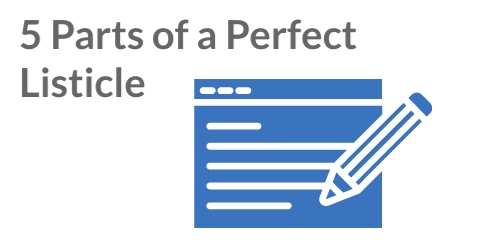If you have ever experienced the sudden realisation you have lost a few hours to an internet ‘timesuck’ the chances are that Buzzfeed is to blame, or more specifically a listicle.
Listicles are those articles that are structured as a list. There is ‘something’ about the presentation of content in list form that makes it hard to leave the page. The items on the list are usually Top 3, 5, 10 with a paragraph or two explaining each point or massive lists like 45 or 100 ways to… Generally the more items on the list the shorter the accompanying text is.
I usually manage to tear myself away after 15 -20 but maybe I just have a really short attention span.
But as I start to go through a list I am possessed, completely drawn to what’s next on the list. And usually, if I do manage to leave the list invariably there is an irresistible title to tempt me into another zombie scrolling session. Although there is one variation that I loathe, with a passion. And that is those which are structured so that you have to click the next page to get the next juicy tidbit. I guess I feel happier when there is a less blatant way to get me to see ads, and view pages.
Listicles are actually not as easy to write as you may think. Condensing ideas or facts into a few short sentences and even deciding which are important enough to include can be challenging.
Now, an article about listicles just wouldn’t be right if it wasn’t written as a listicle so here are my 5 parts of a perfect Listicle.

1. The Listicle Title Goes First.
The Title of a listicle needs not only to give the audience details of the content it needs to convince them to read it. It is estimated that only 20% of people continue to read an article while 80% never get past the title
You can, of course, edit the title after completing the listicle but deciding on the title before writing the list will control your writing style and the information you research. Remember, we need short to the point text not rambling prose to make a good listicle. The title needs to capture target the reader’s attention, state what information a reader will learn and how much of information the listicle contains (the number of points on the list). There are a number of styles of lists Top 10 lists, Random lists, Guides, Checklists, cheat sheets and so on. So, 5 reasons to… Top 20… 200 ways to… are the kind of titles you will see on listicles
2. Do the Research
If you are going to list the most important parts of a subject then you need to know more than just what you list so unless you are already a subject matter expert (well even if you are a subject matter expert) you need to do in-depth research on the subject
Effective research is time-consuming, but important. Make sure you find and use trustworthy sources and know your subject well.
3. Choosing the Content
To decide What Information to Include it is a good idea to research your competition. Don’t copy their list, find out things they missed and build your list out of those facts.
Make your listicle more useful and detailed than others on that subject or choose a slightly different angle, if it will benefit the reader.
4. Break it Up
If your list is long or contains lots of text add pictures or use subheadings to break it up and make it easier to read. Especially if you are writing a 100 ways to… article you may wish to group points that logicall go together under a subheading to enable skimming, as it is unlikely anyone will read the whole list.
5. Add an Introduction and Conclusion
You may be forgiven for thinking that if you have a great list and a great title then you are done, your listicle is complete – but if your title has enticed someone to read more then a strong introduction will draw them in further. Just like the title the introduction needs to make them hungry for more.
Reward the readers who make it to the end of your listicle with a strong conclusion, don’t just leave them wondering why they read it. In your conclusion repeat what you think your readers need to remember. Don’t add anything extra just summarize what you said previously. Encourage feedback from your readers or encourage them to take action.
Conclusion
The key to a perfect listicle is a compelling title, good research, great content, well organised text, and a strong introduction and conclusion. Listicles are still effective pieces of content, but as they are so popular it takes skill and hard work to make them stand out. Try including these 5 parts in your listicle and let me know the results.
13 Replies to “5 Parts of the Perfect Listicle”
Comments are closed.